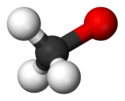- Sodium methoxide
-
Sodium methoxide 

 sodium methoxideOther namessodium methylate
sodium methoxideOther namessodium methylateIdentifiers CAS number 124-41-4 
PubChem 10942334 ChemSpider 29033 
UNII IG663U5EMC 
Jmol-3D images Image 1 - [Na+].[O-]C
Properties Molecular formula CH3NaO Molar mass 54.02 Appearance white solid Melting point >300 °C
Hazards MSDS Oxford MSDS EU classification Harmful (Xn), Corrosive (C)  methoxide (verify) (what is:
methoxide (verify) (what is:  /
/ ?)
?)
Except where noted otherwise, data are given for materials in their standard state (at 25 °C, 100 kPa)Infobox references Sodium methoxide is a chemical compound, with formula CH3ONa. This colourless solid, which is formed by the deprotonation of methanol, is a widely used reagent in industry and the laboratory. It is also a dangerously caustic base.
Contents
Preparation and structure
Sodium methoxide is prepared by carefully treating methanol with sodium :
- 2 Na + 2 CH3OH → 2 CH3ONa + H2
The reaction is so exothermic that ignition is possible. The resulting solution, which is colorless, is often used as a source of sodium methoxide, but the pure material can be isolated by evaporation followed by heating to remove residual methanol. The solid hydrolyzes in water to give sodium hydroxide, and commercial samples are significantly contaminated with the hydroxide. The solid and especially solutions absorb carbon dioxide from the air, thus diminishing the effectiveness of the base.
In the solid form, sodium methoxide is polymeric, with a sheet-like arrays of Na+ centers, each bonded to four oxygen centers.[1]
The structure, and hence its basicity, of sodium methoxide in solution depends on the solvent. It is significantly stronger base in DMSO where it is more fully ionized and free of hydrogen bonding.[2]
Applications
Organic synthesis
Sodium methoxide is a routine base in organic chemistry, applicable to the synthesis of numerous compounds, ranging from pharmaceuticals to agrichemicals.[2] As a base, it is employed in dehydrohalogenations and aldol condensations. It is also a nucleophile for the production of methyl ethers. [3]
Industrial applications
Sodium methoxide is used as an initiator of anionic addition polymerization with ethylene oxide, forming a polyether with high molecular weight. Biodiesel is prepared from vegetable oils and animal fats, that is, fatty acid triglycerides, by transesterification with methanol to give fatty acid methyl esters (FAMEs). This transformation is catalyzed by sodium methoxide.
Safety
Sodium methoxide is highly caustic, and the hydrolysis gives methanol, which is toxic and volatile.
References
- ^ E. Weiss, “Die Kristallstruktur des Natriummethylats” Zeitschrift fur Anorganische und Allgemeine Chemie 1964, volume 332, p. 197-203. doi:10.1002/zaac.19643320311
- ^ a b Y. El-Kattan, J. McAtee, B. Bessieres “Sodium Methoxide” in Encyclopedia of Reagents for Organic Synthesis, John Wiley & Sons, 2006, New York. doi:10.1002/047084289X.rs089m.pub2. Article Online Posting Date: September 15, 2006.
- ^ Frederic Reverdin, "3,5-Dinitroanisolel", Org. Synth., http://www.orgsyn.org/orgsyn/orgsyn/prepContent.asp?prep=cv1p0219; Coll. Vol. 1: 219
See also
Categories:- Alkoxides
- Sodium compounds
Wikimedia Foundation. 2010.
